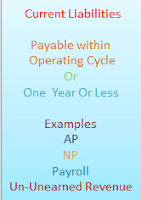Current Liabilities Definition And Examples
 We already familiar with Current Liabilities in our previous articles but here
we discuss them in more details and explain them with important examples.
We already familiar with Current Liabilities in our previous articles but here
we discuss them in more details and explain them with important examples.Current Liabilities Definition:
These are the liabilities that are
paid out for the current Accounting Period of time or with the total period of
one year.
Types of Current Liabilities / Examples of Current Liabilities
Here are most important examples
of Current Liabilities.
From time to time, businesses may
purchase goods from suppliers on Credit basis for resale purposes. They are
also called Creditors. Accounts Payable sells goods on credit to those
companies that can repay their credit amount in time. So, they check their
Working Capital through Financial Statements. The suppliers can give discount
to these companies on sale.
Accounts Payable includes Trade Accounts and
Other Accounts Payable. Trade Accounts Payable give credit during trading or in
case of Inventory or merchandise. For Example, getting credit on buying goods
or services. Other Accounts Payable may include those persons that can give you
Credit other than Inventory or merchandise. For Example, Expenses Payable, Rent
Payable, etc.
· Notes Payable
So, it is all about Current Liability Definition and
its Examples and we can say that it is very necessary for the business to
monitor it in order to improve the working capital of the business and
ultimately to run the business smoothly.
What Are Notes Payable?
Notes Payable Definition:
Examples include Bank Loans, Purchase of
Costly Office Equipment, Purchase of Inventory or merchandise, etc.
· The Current Portion of Long-Term
Debt
It includes short-term borrowings
like taking loans from banks for mortgage property. The current portion of loan
is the principal amount that is payable on monthly, quarterly, Semi-Annually
and Annual Basis. This Current portion is treated as Current Liability.
When expenses are not paid but the
benefits are attained for its utilization. Examples include Salaries Payable, Telephone Expenses,
Utility Bills, etc.
As we do not make payment for our
expenses, so these expenses are also called Accrued Expenses.
· Payroll Liabilities
An Entrepreneur not only pays salaries, wages to
its employees but also pay any benefit provided under the law. Payroll includes
wages, salaries and other costs required by law.
Payroll includes:
Rs.
+ Salaries + Wages 100000
+ Social Security
And Medical Relief 7000
+ Federal Taxes 5000
+ Unemployment Taxes 3000
+ Workers
Compensations 2000
________
Total Payroll Costs 117000
________
It is the Revenue which
is actually not earned by the entrepreneur but the amount of payment is
received from the customer.
In Other words, we can say that the amount
received from the customers for the services not actually rendered by the
business. In this case, the company receives the fees in advance. Now it is the
Current Liability of the company to render the services in the future period of
time because it is done within the operating cycle of the business.
Comments